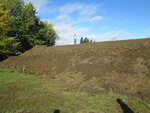
Editor’s note: This article is part of an ongoing series highlighting projects that have been completed as part of the Chehalis Basin Strategy. These projects are implemented in cooperation with partners such as the Chehalis River Basin Flood Authority, the Confederated Tribes of the Chehalis Reservation, the Quinault Indian Nation, state agencies, local governments, nonprofit organizations, landowners and the Aquatic Species Restoration Plan team. The Chronicle has partnered with the Office of Chehalis Basin for this series. Read previous installments at chronline.com.
In December 2007, a record-setting flood deluged the Chehalis Basin, causing $930 million in total damages. Basin agriculture also suffered, losing livestock, production rates and equipment. In response, Lewis County and Grays Harbor conservation districts, along with the Washington State Conservation Commission, came together with farmers to design an approach that could prevent future agricultural losses during flood events. From 2011 through 2016, the districts, the commission and basin farmers designed and permitted elevated farm pads and evacuation routes on properties susceptible to flooding. Working with the Chehalis River Basin Flood Authority, the Chehalis Basin Strategy provided $866,000 to construct 20 farm pads and evacuation routes in Lewis County and three in Grays Harbor County. By fall 2017, all 23 of the elevated structures were complete. In part because of these structures, when the next record-setting flood occurred in the Basin in January 2022, there were no reported losses of animals or farm equipment.
The problem
When major flooding occurs in the Chehalis Basin, the lives and livelihoods of many area farmers are adversely affected by severe losses. During the December 2007 flood, for example, basin farmers lost thousands of commercial livestock, including 400 dairy cows, to the flood. On average that year, area dairy farmers also lost about $1 million per dairy due to the major flood. In addition, farm equipment was lost to floodwaters, causing approximately $5 million in damages.
The project
To help avoid future catastrophic losses, the Lewis and Grays Harbor conservation districts, along with the Washington State Conservation Commission, worked with basin farmers from 2011 through 2016 to design and permit elevated farm pads and evacuation routes on properties susceptible to flooding.
A farm pad is an elevated, earthen corral. The pads are fenced with a closed gate to keep animals such as cattle, goats, horses and sheep contained and out of harm’s way during a flood. The farm pads also include animal feed and a place for keeping farm equipment and farm chemicals above water.
Working with the Chehalis River Basin Flood Authority, the Chehalis Basin Strategy provided $866,000 to construct 20 farm pads and evacuation routes in Lewis County and three in Grays Harbor County. Construction of all 23 farm pads was complete by fall 2017.
“Farm pads save lives and livelihoods,” said Scott Boettcher, who works with the Chehalis River Basin Flood Authority. “There’s been a great return on the public’s $866,000 investment. Elevated pads are helping protect basin livestock and farm equipment valued at $9.3 million. That’s a 14 to 1 return for a reusable asset.”
The impact
Boettcher said local conservation districts aren’t currently engaged in building and permitting more elevated structures because the basin’s entire commercial herd now has access to farm pads and evacuation routes.
As previously covered by The Chronicle, farmers with farm pads in areas with the heaviest rainfall and flooding during the more recent major flood in January 2022 were able to use the structures to protect their animals and equipment. There were no reports of animals drowning or equipment losses during the event.
Jim Getchman, natural resource technician for Grays Harbor Conservation District, helped design and worked to permit the three farm pads in the county. One of the three farmers with a farm pad is “very grateful” for it, he said.
“He told me his farm pad has worked out perfectly,” Getchman said. “Livestock pretty much know right where to go when they see or sense rising water.”